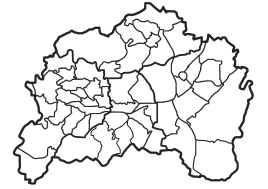Nüdelshalbach
|
Nüdelshalbach
City of Remscheid
Coordinates: 51 ° 11 ′ 39 ″ N , 7 ° 12 ′ 2 ″ E
|
||
|---|---|---|
| Height : | 218 m above sea level NN | |
| Postal code : | 42855 | |
|
Location of Nüdelshalbach in Remscheid |
||
Nüdelshalbach is a residential area in the northern district of Lüttringhausen in the Bergisch city of Remscheid . The Hofschaft is south of Goldenberg . The Müggenbach, also called Mückenbach, which rises near the underpass in Remscheid, flows into the Morsbach below the Amboss-Weg.
history
The first written mention of the court was in 1471 as Nuls Halbach . Further mentions were made as Nultze yn der Halbech and Nolzen Halbach . In the 16th century, the estate was an allod of the Johanniter- Stift zu Burg and belonged to their Remscheid Villication under the Oberhof Stachelhausen . It was "an old treasure belonging to the Hohenhagen community".
The court is also known as "Arnolshalbach", named after a resident called "Arnold". In the 17th century there were numerous hammer mills here, including a Reckhammer in the Mückenbachtal . The Mückenbach once provided a lot of water power from the underpass to the Haddenbach . The "Schmitzkotten" located on this brook was named in the Lüttringhauser directory from 1853 when it was 260 years old. But the official information does not start until 1710. The Schmitzkotten emerged from the Nüdelshalbacher mill, which existed in 1710 as "Bertrams Mühle". It was also called "et Möllschen" or "et Köttschen". In 1749/50 it was listed as "Mahlmühlgen in the Nüdelshalbach". "The waters were the property of the sovereign, who had taxes levied for the use of water power. Stursberg mentions in 1773 that the mill is run by a Krasch (Crasch). Details are not known. In 1800 it can be read that the grinding mill was part of the" hereditary community Loes in the Nüdelshalbach, privileged by the old, 2 Reichstaler, 8 alb. "Have to pay". In 1834 the mill appeared for the first time as an anvil hammer from Gottlieb Hasenclever in the Nüdelshalbach, and it can be read in the address book: "Gottlieb Hasenclever, Entrepeneur einer Amboshammer". In 1842 JP Kuhler is given as the owner. He operated the hammer with three workers and an inventory of two hearth fires and an anvil .
In 1710 the later broad hammer was first mentioned in a document as "Hammer am Semperbroich by Diederich Hasenclever's heirs to Nüdelshalbach". The Breithammer (the pond is still a bit smaller today) passed into the possession of Goldenberger Carl Kleuser on May 1, 1864 , who was previously a steel trader and whose family processed steel until the end of the 20th century. In 1918 three large steam hammers weighing 25, 60 and 100 hundredweight were installed.
Two restaurants, a bakery, a grocery store, a small tool shop and some rural properties as well as two hammer forges in the valley brought life to the Nüdelshalbach until after the Second World War. For a long time, the city of Remscheid maintained a senior citizens' meeting on the footpath to Hohenhagen.
Infrastructure
Hermann Kuhler was a brother of Johann Peter Kuhler, who had already converted the scales hammer located on the Mückenbach into an anvil hammer. In 1798 he founded a raw steel hammer "at the same pond as the mill hammer". The family successors are called "Jörres" and currently (2017) still run an extensive industrial company there. Here the short street of the court is called "Ambossweg".
Opposite is the fire station north, which was created by the merger of the volunteer fire brigades Goldenberg, Haddenbach and Grund.
literature
- Hans Kadereit: Where there is still celebrations, reels and delights , a historical illustrated book Lüttringhausen, RGA-Buchverlag, 2009, ISBN 978-3-940491-07-7
- Wilhelm Rees: Local history booklets of the Remscheid City Archives No. 7
Individual evidence
- ^ Ernst Erwin Stursberg : Alt-Lüttringhausen ; Mann Publishing House; 1950
